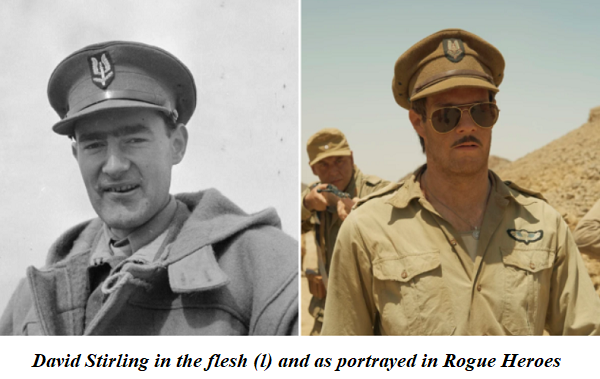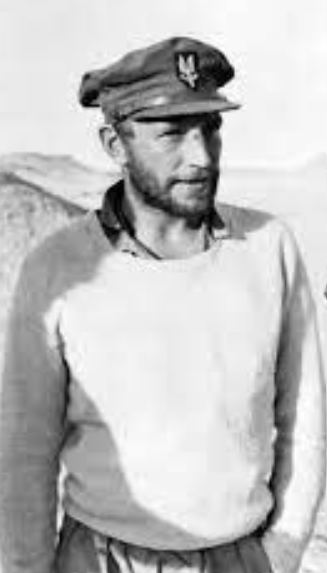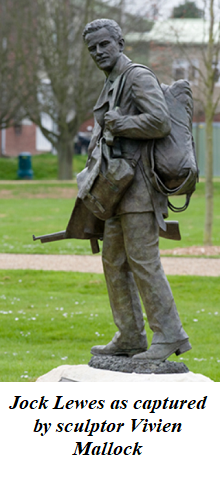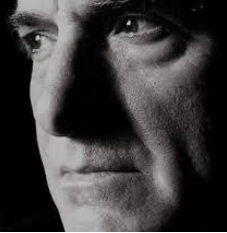
We’ve been approached something like twenty-five times since the war. I kicked each out the window because they weren’t going to make it with the integrity we require the story of the SAS to be told. —Colonel Sir David Stirling, OBE, DSO, co-founder of the SAS
The well-known motto of the SAS (Special Air Service), Britain’s elite special forces unit, is: Who Dares, Wins. It comes from the Latin, Qui audet adipiscitur.
SAS: Rogue Heroes is a 2022 BBC One six-part television series about the origins of the SAS during the Western Desert Campaign of the Second World War. The unit grew from a couple of dozen men to several thousand.
Craig Mathieson of the Age said, “Does [this series] glorify war? To a degree, although as the obligatory audition scene for potential recruits makes clear, their mission is to defeat fascism.”
Joe Dolce’s film reviews appear in every Quadrant.
Click here to subscribe
The story begins, in 1941, 120 miles from Tobruk, in the Egyptian desert. David Stirling, an ex-Scots Guard commando, is frustrated that military administrative red tape is preventing reinforcements from reaching Tobruk, which is now under twenty-four-hour bombardment by the Luftwaffe. Stirling comes up with a plan of putting together an elite group of well-trained malcontents to form a secret parachute regiment to land in the desert interior and destroy Rommel’s airfields and supply convoys. With its dangerous updrafts, no one has ever parachuted into the desert before.
Irishman Paddy Mayne has been thrown in jail for fighting with a military policeman. Three military police come into his cell at night with a noose, prepared to hang him, but Mayne’s superior combat skills allow him to get the better of them and he escapes.
Unaware of Stirling’s idea, Colonel Dudley Wrangel Clarke meets with Eve Mansour, a French intelligence officer posing as a journalist, working for General Charles de Gaulle. He tells her he has created an entire fictional British commando unit, called the SAS, utilising wooden planes and actors as the soldiers in photos. His “Plan Abeam” is a ruse of misinformation that’s intended to find its way to Berlin in an attempt to convince the Nazi high command of a new British parachute battalion in East Libya. Mansour advises Clarke that Stirling is creating something similar—with real soldiers.
Stirling tells Mayne, who is now incarcerated again for striking a superior officer, that he needs him for a special unit he is forming. There will be no one to answer to. The idea appeals to the insubordinate Mayne.
Stirling persuades General Sir Claude Auchinleck of the merit of his plan and gets authorisation for a “ghost regiment”, L Detachment, 1st Brigade Special Air Service, dubbed the SAS, after Clarke’s fictional unit.
Stirling selects sixty soldiers. He wants to attack immediately; to blow up all the enemy fighter aircraft on the ground while they are still sitting on their desert airstrips—in one night.
Under the codename Operation Squatter, Stirling and his men parachute into the middle of a severe desert storm, with winds up to sixty miles per hour. The men are blown all over the place—not one lands within ten miles of the intended drop zone. One of the planes is shot down, killing all fifteen soldiers and crew. On hitting the ground, one man’s spine snaps; another breaks an arm. They are completely out of communication with each other. To complicate matters, the worst rainstorm in the desert in twenty years—a biblical-style flood—descends on them, creating quicksand and chest-high water. There are only eight left in Stirling’s party but they decide they have to attack the airfields anyway. Stirling’s unit fortunately runs into two other units of his men making their way across the sand but there are only twenty-two survivors left of the original fifty-five parachutists.
Jock Lewes has designed twenty small custom-made bombs for each man, which can operate on both short and long fuses. The surviving SAS attack the Tamet airstrip, planting Lewes’s bombs on as many trucks and planes as they can, set with ten-minute fuses, destroying them. They surprise the unarmed drunken Nazi soldiers in a mess hall tent, who outnumber them ten-to-one, and kill them all.
General Auchinleck is impressed by the results. Stirling is promoted to the rank of major. Mayne receives the Distinguished Service Order and is promoted to captain. The men are given white berets and a motto: Who Dares, Wins. The blatant white colour has been chosen intentionally to provoke the soldiers outside their unit, Dudley commenting, “There’s nothing like a bar-room brawl to bring men together.” Twenty French paratroopers arrive to join the group and Mayne is selected to train them. Randolph Churchill, the son of Winston Churchill, joins the unit and accompanies them on their next mission.
Prime Minister Churchill meets Stirling and affirms that this style of warfare is exactly what’s needed now that Tobruk has fallen. Malta is still under attack and Churchill encourages him to a launch further simultaneous ghost attacks on six key airfields along the coast.
SAS: Rogue Heroes was created and written by Steven Knight, director of the popular series Peaky Blinders (2013 to 2022). The series was adapted from the book of the same name by British writer Ben Macintyre, a regular columnist for the Times and the author of For Your Eyes Only: Ian Fleming and James Bond (2008) and A Spy Among Friends: Kim Philby and The Great Betrayal (2014); the latter was adapted into a six-part television series, A Spy Among Friends. Macintyre also wrote the memorable Forgotten Fatherland: The Search for Elizabeth Nietzsche (1992), which I discussed in Quadrant in July-August 2013.
Macintyre acquired the bulk of his source material for his book SAS Rogue Heroes from regimental archives and the SAS War Diary. Antony Beevor, the best-selling author of Stalingrad, D-Day: The Battle for Normandy and Ardennes 1944, said, “Impeccably researched, superbly told—by far the best book on the SAS in World War II.”
Sir David Stirling was a Scottish officer in the British Army. He had wanted to be the first person to climb Mount Everest and was training for the trek when the war broke out. Stirling joined the Scots Guards in 1937, training in the ski battalion. Because of his stealthy desert brilliance, Nazi Generalfeldmarschall Erwin Rommel nicknamed him “The Phantom Major”. After the war, he and John Woodhouse formed Watchguard International Ltd, to provide British weapons and personnel for privatised foreign policy operations in the Gulf States. In 1971, he was involved in a failed attempt to overthrow Muammar Gaddafi. He was appointed Knight Bachelor in the 1990 New Year Honours for service to his country.
Jack O’Connell, who plays Paddy Mayne, appeared in the BBC miniseries The North Water (reviewed in Quadrant, December 2021). There are a few interesting parallels between the lives and temperaments of O’Connell and Mayne.
At sixteen, O’Connell left Saint Benedict Catholic School with two General Certificates of Secondary Education, in drama and English. He spoke of his “brutal” experience there: “What I learnt aside from anything academic at school was probably very valuable lessons in terms of how to lie, how to play the game, how to play authority against itself.”
He intended to become a professional footballer and played as a striker for Alvaston Rangers, and was later scouted by Derby County, but injuries ended this career. He tried to join the British Army but his juvenile criminal record prevented him from enlisting. Ironically, back in the 1940s, these were some of the very qualities the fledgling SAS were looking for!
When Stirling chose Paddy Mayne to be part of his early SAS team, Mayne was under arrest for punching his commanding officer. In 1936 he was the Irish universities heavyweight champion and reached the final of the British universities championship. He played rugby from the age of sixteen for the local Ards RFC. After achieving six Ireland rugby caps, he was selected for the 1938 British Lions tour to South Africa. During the tour, friends said that he “relaxed” by smashing up colleagues’ hotel rooms and “fighting dockers”.
Mayne was fond of practical jokes. In the series, to vacate a pool table, he puts a grenade on the table and pulls the pin. Everyone scatters. It was a dummy. The scene was based on an actual event in Paris in 1944, when to clear a French crowd from a buffet table, he did the same thing.
The British author Gordon Stevens said:
In 1944, the SAS used Hylands House [in Essex] as their Headquarters. On one memorable occasion, Captain Paddy Mayne attempted to drive a Jeep up the Grand Staircase for a bet. The incident caused much commotion and [the owner] Christine Hanbury dispatched the men to bed with instructions to remove the Jeep in the morning when they had clearer heads. The Jeep had to be dismantled before it could be removed.
After the Dunkirk evacuation, when Winston Churchill sought to form a “butcher and bolt” raiding party,  Mayne volunteered for the No. 11 Scottish Commando. He saw distinguished action in the Syria–Lebanon Campaign and the Battle of the Litani River against Vichy French Forces in Lebanon.
Mayne volunteered for the No. 11 Scottish Commando. He saw distinguished action in the Syria–Lebanon Campaign and the Battle of the Litani River against Vichy French Forces in Lebanon.
Stirling said, “Mayne (left) was one of the best fighting machines I’d ever met in my life. Paddy had a marvellous battle nostril.” Macintyre wrote of him, “A frustrated poet and bar-room brawler, this man was 17 stone [about 108 kilograms] of highly volatile human explosive.”
But Billy Foley, in the Irish News, said Mayne was far from being “a brutish, rough man … looked down on by the aristocracy of his native Newtownards … [or that he] despised the toff officer class of the British army. [He] was, in fact, born to a landed family … and studied at Queen’s University Belfast before qualifying as a solicitor.”
Stirling didn’t trust the media to get the SAS’s story right. The SAS had a code of extreme secrecy—no one liked talking to anyone outside their unit. After all, the Middle East Headquarters in Cairo was known to be infested with spies. Secrecy became a necessary habit and much of the information about the SAS is still highly classified.
Beevor said, “That generation of men just didn’t talk about their experiences so there is very little information around. They had a huge respect for things like the Official Secrets Act and the SAS were even more security conscious than most.” Former SAS member Mike Sadler commented, “Even today I think twice when it comes to speaking about [it].”
Gordon Stevens secured the only known interviews with David Stirling and his men, which were published in his book The Originals: The Secret History of the Birth of the SAS (2005). The book is laid out as a sequence of dialogues, in the members’ own words.
Brevet Lieutenant André Zirnheld was a member of the Free French and the French SAS. A philosophy teacher before the war, he was killed in action and buried in the desert. He left a poem, “The Paratrooper’s Prayer”, in his possessions, and it is included in Stevens’s book. Here is an excerpt:
I bring this prayer to you, Lord,
For you alone can give
What one cannot demand but for oneself.
Give me, Lord, what you have left over.
Give me what no one else asks you for.
Stirling said he fought two battles to get the SAS established: the battle in the desert and the battle with his commanding officers at the Middle East Headquarters, which he referred to as “layer upon layer of  fossilised shit”.
fossilised shit”.
He remarked: “In a sense, the men [I chose] weren’t really controllable. They were harnessable … once they were harnessed, they policed themselves.”
The Lewes bomb was an actual improvised explosive device. Lewes wanted a bomb portable enough to carry but strong enough to destroy an enemy aircraft.
Sergeant Jeff Du Vivier was one of the five men involved in the crucial desert missions. However, his character was omitted from the series. But Du Vivier gives a vivid description of the Lewes bomb from a diary he kept during training at Kabrit:
It was plastic explosive and thermite—which is used in incendiary bombs—and we rolled the whole lot together with motor car oil. It was a stodgy lump and then you had a No. 27 detonator, an instantaneous fuse and a time pencil. The time pencil looked a bit like a “biro” pen. It was a glass tube with a spring-loaded striker held in place by a strip of copper wire. At the top was a glass phial containing acid which you squeezed gently to break. The acid would then eat through the wire and release the striker. Obviously the thicker the wire the longer the delay before the striker was triggered [the pencils were colour coded according to the length of fuse]. It was all put into a small cotton bag and it proved to be crude, but very effective. The thermite caused a flash that ignited the petrol, not just blowing the wing off but sending the whole plane up.
Beevor, in the Guardian, commented that SAS: Rogue Heroes was “unmissable viewing [and] achieved the right balance of irreverence and admiration all the way through with a brilliant contrast in characters”. Mathieson wrote in the Age:
Rogue Heroes is a revisionist war tale. It’s in thrall to the anti-authority misfits and violent outcasts who raged against the British military machine until they were given their own unit. Considered a helpful decoy more than an offensive weapon against the Italian and German forces pushing towards Cairo and the vital Suez Canal, the nascent SAS helped change the course of the campaign with unconventional tactics and a hunger for combat verging on the suicidal.
Vicky Jessop of the Evening Standard highly commended the series:
it’s a fizzy, stylish wartime drama with enthusiasm to spare, as well as a clear love for the story being told. It’s propulsive and addictive, rather like jumping out of a plane probably is, if you happen to be mad enough.
Stevens said:
It is also a very human story of a gang of misfits coming together to create a unit like no other: a maverick son of a Scottish laird; a boy who lied about his age to enlist; a policeman; a cheeky cockney; a Lincolnshire boxer; an Irish rugby international imprisoned for beating up his commanding officer; an Oxford rowing president and a quietly spoken man of God.
The soundtrack was scored by Ilan Eshkeri, who did the music for The Young Victoria (2009). The series is loaded with terrific songs, and even though they don’t quite fit the period, it doesn’t matter. Benny Goodman, Black Sabbath, The Cure, Noël Coward, Cream, The Stranglers, The Clash, Killing Joke and Florence Desmond all come together throughout the six episodes. AC/DC’s “Thunderstruck” is also included. This great song has been in two other movies I am aware of: Ironman (2008) and a particularly memorable version in the sci-fi film Battleship (2012).
Gordon Stevens also made two film documentaries on the SAS. One was a version of his book, titled The Originals (2005), in which he interviews Stirling and other unit members. The film is held by the SAS at their museum. He also made a practically impossible-to-find television special called Secret Hunters (1986). Damien Lewis, in his book SAS Nazi Hunters: The Ultra-Secret Unit and the Hunt for Hitler’s War Criminals, tells this little-known story of a secret unit of the SAS who covertly tracked down escaped Nazis who had committed war crimes against SAS soldiers in France.
In 1944, two months after D-Day, in a mission named Operation Loyton, SAS parachuted into the Vosges mountains, on the Franco-German border, to arm and train the French resistance. Their mission was to destroy the supply lines of the fleeing German army. But they landed in the middle of the 11th Panzer Division—5000 German soldiers with 140 tanks. Thirty-one members of the SAS unit disappeared. The partisans of the surrounding villages were rounded up and sent to Natzweiler, a Nacht und Nebel (night and fog) camp, the only concentration camp built in France.
A year later, Winston Churchill lost the general election and the SAS was disbanded as redundant. The German war was over and the Soviet Union was now viewed as the primary looming threat. Britain was practically bankrupt from war expenses.
But evidence surfaced that the Operation Loyton parachutists had been captured, tortured and executed by the Gestapo. The commander of 2 SAS, Colonel Brian Franks, vowed to give them justice. Stirling said, “Had it not been for Brian Franks, we would have been consigned to oblivion.”
Franks created an SAS survival plan, with Churchill as patron despite his political defeat. There was no official government support. Frank’s small group of SAS operatives, “the secret hunters”, continued in secret. Hardly anybody else, even in the SAS, knew they existed.
Their first lead came in a most unlikely way. A ouija board had been set up in someone’s parlour with numbered playing cards and the letters of the alphabet. An upturned glass was placed beside the board. The glass spelled out a name, “Fordham”, and the words “I was killed at Cirey”, a village in the Vosges.
Franks’s secret unit flew to Cirey to investigate and were led by villagers to some unmarked graves. They dug up two bodies. The men turned out not to be SAS but members of the Canadian Air Force. Still, they had uncovered a war crime.
The mysterious ouija board also gave them the name of the Gestapo officer who had done the killing. Further investigation led to a mass grave with eight SAS bodies and a series of other unmarked graves with other SAS soldiers, many shot in the head, execution-style.
The SAS unit captured over a dozen war criminals, even snatching some off the street. During war crimes trials in 1946, eleven Nazis were convicted, five were hanged, and the rest got short prison sentences. One of the officers responsible, who was reported as hanged, was said to have been slipped away to the US to work for the CIA.
Stirling said:
I have always felt uneasy in being known as the founder of the regiment. To ease my conscience, I would like it to be recognized that I have five co-founders: Jock Lewes, Paddy Mayne, George Bergé, Brian Franks, who re-raised the flag after the war, and John Woodhouse, who created the modern SAS.
SAS founding member Mike Sadler, now aged 103 and blind, lives at Arlington Manor Care Home in Cambridgeshire. He is the last of the original team. He was part of the first successful SAS raid on Wadi Tamet airfield, where six men destroyed twenty-four aircraft and a fuel dump. He was a key member of the team in the jeep raid on Sidi Haneish airfield, as they drove straight down the tarmac in two columns, with twin Vickers K machine guns blazing to left and right, blowing up forty aircraft.
Poached from the artillery by Stirling, Sadler became the Long-Range Desert Group’s top navigator, also fighting with the SAS in Italy and France before setting up the SAS intelligence unit. In an interview with the series producer Stephen Smallwood, Sadler said:
One of [Stirling’s] major requirements was that he wanted people who’d be able to get on with each other in difficult circumstances. He was more interested in that, in a way, than what their qualifications were. And so he looked for people he thought had what he needed, but the ones who took priority were the ones who could get on with each other—and with him as well.
Sadler was awarded the Military Cross for gallantry, the Military Medal, and France’s highest distinction, the Legion d’Honneur. He remarked:
Overall I loved the desert, I thought it was absolutely perfect. I was very sorry to leave at the end of the desert war because it was something like being on the sea in a way. You could go in any direction —there was a great sort of freedom attached to being in the desert. There was so much variety of going: beautiful smooth surfaces, sand, and impassable great sand dunes hundreds of feet high. Slowly moving across the desert with the prevailing wind, the sand dunes moving very slowly, perhaps a foot every year or something like that but altering their arrangements quite considerably. Oh yes, I thought the desert was a wonderful place.
Macintyre’s book contains many descriptions of campaigns and operations conducted by the SAS throughout the war that are not covered in the series, including the invasion of Germany and the liberation of the Bergen-Belsen concentration camp, whose horrors psychologically scarred many of the battle-hardened SAS veterans.
A second season of SAS: Rogue Heroes has been commissioned, based on later operations in the European theatre of war. I hope it will include the little-known story of Operation Loyton.
 Sign In
Sign In 0 Items (
0 Items ( Search
Search










Series one is available for streaming now on Netflix. Catch it if you can. It is superb action drama with just enough wartime urban intrigue and loves to complement, for this female viewer anyway, the testosterone fuelling in the deserts, a men-only world of guns-blazing daring-do which is so believably evoked. And sometimes very sad and moving.
I looked forward to watching this program but was disappointed the producers chose to represent Australians as gormless drunks lacking in courage and Kiwis as being gullible enough to allow a couple of British “Ruperts” to pilfer their stores and equipment at will. Notwithstanding creative licence the fact is that 80 years later the history of the period is well known and documented. The allies and in particular Australian, New Zealanders along with British infantry and artillery were heroics in defeating Rommel. Reflecting on the facts of the time perhaps the producers should have put aside the silly parodies of allied soldiers and acknowledged that without them it’s unlikely the Axis powers would have been defeated. The SAS were largely irrelevant to that outcome.
Sorry, it is on SBS Freeview, and streaming on Amazon Prime. Not Netflix.
It’s been something of a sleeper, work of mouth carrying it to greater heights.
Thanks, will look for it.
Haven’t come across ACDC’s ‘Thunderstruck’ as yet but the series opens with their far superior Bon Scott era ‘If You Want Blood’, and a bit later ‘Live Wire’.
I was a little wary of watching this series thinking it was going to be all gung-ho fiction. Far from it, it was fascinating material presented in sober detail showing very brave and dedicated men fighting behind the lines to defeat the rampant Rommel and his forces. Very highly recommended and, as Joe Dolce writes, let us hope the second series also covers the Operation Loyton episode.
If the SAS’s mission is to defeat fascism, then they must fight against ANTIFA, BLM, CIA, FBI, MI5, AHPRA, TGA, FDA, CDC, NIH, DHHS, NHS, WEF, Bill and Melinda Gates Foundation, WHO, UN, Trusted News Initiative, BBC, ABC, IPPC and so many more modern day fascist organizations.